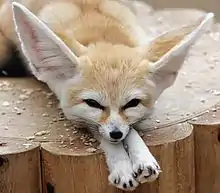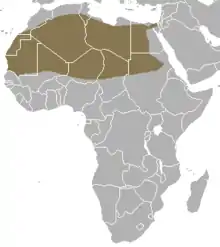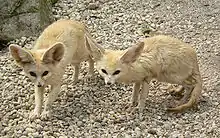Fennec fox
The fennec fox (Vulpes zerda) is a small crepuscular fox native to the Sahara Desert and the Sinai Peninsula.[1] Its most distinctive feature is its unusually large ears, which serve to dissipate heat. The fennec is the smallest canid species. Its coat, ears, and kidney functions have adapted to the desert environment with high temperatures and little water. Also, its hearing is sensitive to hear prey moving underground. It mainly eats insects, small mammals, and birds. The fennec has a life span of up to 14 years in captivity and about 10 years in the wild. Its main predators are the Verreaux's eagle-owl, jackals, and other large mammals. Fennec families dig out burrows in the sand for habitation and protection, which can be as large as 120 m2 (1,292 sq ft) and adjoin the burrows of other families. Precise population figures are not known but are estimated from the frequency of sightings; these indicate that the fennec is currently not threatened by extinction. Knowledge of social interactions is limited to information gathered from captive animals. The fennec is usually assigned to the genus Vulpes; however, this is debated due to differences between the fennec and other fox species. The fennec's fur is prized by the indigenous peoples of North Africa, and in some parts of the world, it is considered an exotic pet.
| Fennec fox | |
|---|---|
 | |
| Scientific classification | |
| Kingdom: | Animalia |
| Phylum: | Chordata |
| Class: | Mammalia |
| Order: | Carnivora |
| Suborder: | Caniformia |
| Family: | Canidae |
| Subfamily: | Caninae |
| Tribe: | Vulpini |
| Genus: | Vulpes |
| Species: | V. zerda |
| Binomial name | |
| Vulpes zerda (Zimmermann, 1780) | |
 | |
| Fennec range | |
Its name comes from this species' name in Arabic: fanak (فَنَك).[2]
Taxonomy

Canis (zerda) was the scientific name proposed by Eberhard August Wilhelm von Zimmermann in 1780.[3] It was placed in the genus Vulpes by Karl Christian Gmelin in 1788.[4] The scientific name Fennecus arabicus was proposed by Anselme Gaëtan Desmarest in 1804.[5]
The fennec fox has 32 chromosome pairs, while other fox species have between 35 and 39. The species also displays behaviors uncharacteristic of foxes, such as living in packs while most other fox species are solitary. Its phylogenetic relationship is presented in the cladogram below.[6](Fig. 10)
| ||||||||||||||||||||||||||||||||||||||||||||||||||||||||||
Description

The fur of the fennec fox is straw-coloured. Its nose is black. Its tapering tail has a black tip. Its long ears have longitudinal reddish stripes on the back and are so densely haired inside that the external auditory meatus is not visible.[3] The edges of the ears are whitish, but darker on the back. The ear to body ratio is greatest in the canid family and likely help in dissipating heat and locating vertebrates. It has dark streaks running from the inner eye to either side of the slender muzzle. Its large eyes are dark. The dental formula is 3.1.4.23.1.4.3 × 2 = 42 with small and narrow canines. The pads of its paws are covered with dense fur, which facilitates walking on hot, sandy soil.[7]
The fennec fox is the smallest canid. Females range in head-to-body size from 34.5 to 39.5 cm (13.6 to 15.6 in) with a 23–25 cm (9.1–9.8 in) long tail and 9–9.5 cm (3.5–3.7 in) long ears, and weigh 1–1.9 kg (2.2–4.2 lb). Males are slightly larger, ranging in head-to-body size from 39 to 39.5 cm (15.4 to 15.6 in) with a 23–25 cm (9.1–9.8 in) long tail and 10 cm (3.9 in) long ears, weighing at least 1.3 kg (2.9 lb).[7]
Distribution and habitat
The fennec fox is distributed in the Sahara, from Morocco and Mauritania to northern Niger, through Egypt and the Sinai Peninsula.[1] It inhabits small sand dunes and vast treeless sand areas with sparse vegetation such as grasses, sedges and small shrubs.[7][8]
Behaviour and ecology

A fennec fox digs its den in sand, either in open areas or places sheltered by plants with stable sand dunes. In compacted soils, dens are up to 120 m2 (1,300 sq ft) large, with up to 15 different entrances. In some cases, different families interconnect their dens, or locate them close together. In soft, looser sand, dens tend to be simpler with only one entrance leading to a single chamber.[7]
Hunting and diet
The fennec fox is an omnivore, feeding on small rodents, lizards, geckos, skinks, small birds and their eggs, fruits and also some tubers. It relies on the moisture content of prey, but drinks water when available.[7] It hunts alone and digs in the sand for small vertebrates and insects. Some individuals were observed to bury prey for later consumption and searching for food in the vicinity of human settlements.[9]
In the Algerian Sahara, 114 scat samples were collected that contained more than 400 insects, plant fragments and date palm Phoenix dactylifera fruits, remains of birds, mammals, squamata and insects.[10]
Reproduction
.jpg.webp)
Captive fennec foxes reach sexual maturity at around nine months and mate between January and April.[11][12] They usually breed only once per year. The copulation tie lasts up to two hours and 45 minutes.[13] Gestation lasts between 50 and 52 days, sometimes also up to 63 days.[14][15] After mating, the male becomes very aggressive and protects the female, provides her with food during pregnancy and lactation.[16] Females give birth between March and June to a litter of one to four pups that open their eyes after 8 to 11 days.[15][12] Both female and male care for the pups. They communicate by barking, purring, yapping and squeaking. Pups remain in the family even after a new litter is born.[11] The pups are weaned at the age of 61 to 70 days.[17]
The oldest captive male fennec fox was 14 years old, and the oldest female 13 years.[7]
Predators
African horned owl species likely prey on fennec fox pups. Anecdotal reports exist about caracals, jackals, striped hyenas also preying on the fennec fox. But according to nomads, the fennec fox is fast and changes directions so that even their Salukis are hardly able to capture it.[7]
Threats
In North Africa, the fennec fox is commonly trapped for exhibition or sale to tourists. Building and expansion of settlements in southern Morocco likely caused its disappearance in this area.[1]
Fennec fox as a pet
The fennec fox is bred commercially as an exotic house pet.[9] Commercial breeders remove the pups from their mother to hand-raise them, as tame foxes are more valuable. A breeders' registry has been set up in the United States to avoid any problems associated with inbreeding.[18] The fennec fox is classified a "small wild/exotic canid" by the United States Department of Agriculture.[19]
Conservation
The fennec fox is listed in CITES Appendix II. It is protected in Morocco, Algeria, Tunisia and Egypt, where it has been documented in several protected areas.[1]
Cultural depictions
_b_033.jpg.webp)
The fennec fox is the national animal of Algeria.[20] It also serves as the nickname for the Algeria national football team: "Les Fennecs".[21]
Fennec was the code name for Mozilla's Firefox for mobile project.[22]
Fennekin, the Fire-type starter Pokémon along with their evolutionary lines from Pokémon X and Y, is based on the fennec fox.[23]
A fennec fox named Finnick was depicted in Disney's Zootopia. As a result of the popularity of the film, Chinese children were begging their parents to procure the animals as pets.[24]
Fenneko, one of main character from the 2018 Netflix's series Aggretsuko, is a fennec fox.[25]
Sonar, a teal fennec fox in the long-running Archie Comics series Sonic the Hedgehog.
A female fennec fox named Popy appeared in the French-South Korean computer animated television series Oscar's Oasis. She is the leader of a trio who have a rivalry with the titular character.[26]
Pip, a rogue alchemist champion from 2016 video game, Paladins is a vulpin, a fennec fox like races.[27]
Vulpera are a race of anthropomorphic fennec foxes that were introduced in MMORPG video game World of Warcraft: Battle for Azeroth.[28]
References
- Wacher, T.; Bauman, K. & Cuzin, F. (2015). "Vulpes zerda". IUCN Red List of Threatened Species. 2015: e.T41588A46173447.
- "Definition of Fennec". www.merriam-webster.com. Retrieved 30 January 2020.
- Zimmermann, E.A.W. (1780). "Der Zerda". Geographische Geschichte des Menschen, und der allgemein verbreiteten vierfüßigen Thiere. II. Enthält ein vollständiges Verzeichniß aller bekannten Quadrupeden. Leipzig: Weygand. pp. 247–248.
- Gmelin, J. F. (1788). "Vulpes cerdo". Caroli a Linné systema naturae per regna tria naturae, secundum classes, ordines, genera, species, cum characteribus, differentiis, synonymis, locis. Tomus I (Editio decima tertia, aucta, reformata ed.). Leipzig: Georg Emanuel Beer. p. 75.
- Desmarest, A.G. (1804). "Genre Fennec, Fennecus Nob.". In Société de Naturalistes et d'Agriculteurs (ed.). Nouveau dictionnaire d'histoire naturelle appliquée aux arts : principalement à l'agriculture et à l'économie rurale et domestique. 24. Tableau méthodique des Mammifères. Paris: Deterville. p. 18.
- Lindblad-Toh, K.; Wade, C.M.; Mikkelsen, T.S.; Karlsson, E.K.; Jaffe, D.B.; Kamal, M.; Clamp, M.; Chang, J.L.; Kulbokas, E.; Zody, M.C.; Mauceli, E.; Xie, X.; Breen, M.; Wayne, R.K.; Ostrander, E.A.; Ponting, C.P.; Galibert, F.; Smith, D.R.; Dejong, P.J.; Kirkness, Ewen; Alvarez, P.; Biagi, T.; Brockman, W.; Butler, J.; Chin, C.-W.; Cook, A.; Cuff, J.; Daly, M. J.; Decaprio, D.; et al. (2005). "Genome sequence, comparative analysis and haplotype structure of the domestic dog". Nature. 438 (7069): 803–819. Bibcode:2005Natur.438..803L. doi:10.1038/nature04338. PMID 16341006.
- Asa, C.S.; Valdespino, C. & Cuzin, F. (2004). "Fennec fox Vulpes zerda (Zimmermann, 1780)" (PDF). In Sillero-Zubiri, C.; Hoffman, M. & Mech, D. (eds.). Canids: Foxes, Wolves, Jackals and Dogs: Status Survey and Conservation Action Plan. Gland, Switzerland: IUCN/SSC Canid Specialist Group. pp. 205–209. ISBN 2-8317-0786-2.
- Karssene, Y.; Chammem, M.; Li, F.; Eddine, A.; Hermann, A. & Nouira, S. (2019). "Spatial and temporal variability in the distribution, daily activity and diet of fennec fox (Vulpes zerda), red fox (Vulpes vulpes) and African golden wolf (Canis anthus) in southern Tunisia". Mammalian Biology. 95 (1): 41–50. doi:10.1016/j.mambio.2019.02.001. S2CID 91615641.
- Asa, C.S. & Cuzin, F.A. (2013). "Vulpes zerda Fennec Fox". In Kingdon, J.; Happold, D.; Hoffmann, M.; Butynski, T.; Happold, M. & Kalina, J. (eds.). Mammals of Africa. Vol. V: Carnivores, Pangolins, Equids and Rhinoceroses. London, New Delhi, New York, Sydney: Bloomsbury. pp. 74–77. ISBN 978-1-4081-8994-8.
- Brahmi, K.; Khechekhouche, E.A.; Mostefaoui, O.; Doumandji, S.; Baziz, Belkacem & Aulagnier, S. (2012). "First quantitative data on the diet of the fennec fox, Vulpes zerda (Canidae, Carnivora), in Algeria". Folia Zoologica. 61: 61–70. doi:10.25225/fozo.v61.i1.a10.2012. S2CID 86211731.
- Gauthier-Pilters, H. (1967). "The Fennec". African Wildlife. 21: 117–125.
- Saint Girons, M.C. (1962). "Notes sur les dates de reproduction en captivite du fennec, Fennecus zerda (Zimmerman, 1780)" (PDF). Zeitschrift für Säugertierkunde. 27: 181–184.
- Valdespino, C.; Asa, C.S. & Bauman, J.E. (2002). "Estrous cycles, copulation and pregnancy in the fennec fox (Vulpes zerda)" (PDF). Journal of Mammalogy. 83 (1): 99–109. doi:10.1644/1545-1542(2002)083<0099:ECCAPI>2.0.CO;2.
- Petter, F. (1957). "La reproduction du fennec". Mammalia. 21: 307–309.
- Gangloff, L. (1972). "Breeding fennec foxes Fennecus zerda at Strasbourg Zoo". International Zoo Yearbook. 12 (1): 115–116. doi:10.1111/j.1748-1090.1972.tb02289.x.
- Sowards, R.K. (1981). "Observation on breeding and rearing the fennec fox (Fennecus zerda) in captivity". Animal Keepers' Forum. 8: 175–177.
- Koenig, L. (1970). "Zur Fortpflanzung und Jungendentwicklung des Wüstenfuchses (Fennecus zerda Zimm. 1780)". Zeitschrift für Tierpsychologie. 27 (2): 205–246. doi:10.1111/j.1439-0310.1970.tb01873.x (inactive 13 January 2021).CS1 maint: DOI inactive as of January 2021 (link)
- Roots, C. (2007). Domestication. Westport: Greenwood. pp. 113–114. ISBN 978-0-313-33987-5.
- "Animal Inventory Sheet" (PDF). United States Department of Agriculture. Archived from the original (PDF) on 5 March 2010. Retrieved 21 December 2009.
- Hodges, K. "National Animals of African Countries". Archived from the original on 25 February 2014. Retrieved 19 February 2014.
- Fifa (2009). "Paris salutes Les Fennecs". Fifa. Archived from the original on 1 June 2010.
- "Mobile/Fennec". Mozilla Wiki. Mozilla Project. Retrieved 9 December 2015.
- "Fennekin (Pokémon) – Bulbapedia, the community-driven Pokémon encyclopedia". bulbapedia.bulbagarden.net. Retrieved 16 February 2018.
- "Inspired by 'Zootopia,' kids in China are begging for rare, protected foxes as pets". Los Angeles Times. 2016. Retrieved 1 April 2016.
- "Aggretsuko (w/green checkmark)". Behind The Voice Actors. Retrieved 14 June 2019.
- "Oscar's Oasis THE HEAT IS ON" (PDF). Cake Entertainment. Archived from the original (PDF) on 12 December 2010. Retrieved 14 July 2011.
- "PIP, THE ROGUE ALCHEMIST". paladins.com.
- "Vulpera". worldofwarcraft.com.
Bibliography
- Alderton, David. Foxes, Wolves, and Wild Dogs of the World. London: Blandford, 1998. ISBN 081605715X.
External links
| Wikispecies has information related to Vulpes zerda. |
| Wikimedia Commons has media related to: |
- About.com Exotic Pets – Entry on fennec fox
- "Fennec fox" at the Encyclopedia of Life

